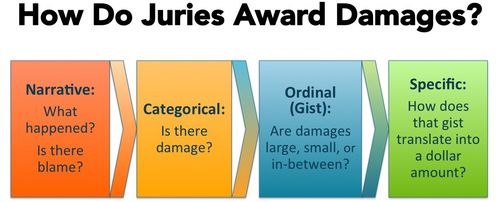By Dr. Ken Broda Bahm:
Flip a coin, roll the dice, pick a number, throw a dart — there is no shortage of metaphors for the perceived randomness of juries. That belief that “anything can happen,” is applied to some extent to the whole jury model, but nowhere more so than on the topic of civil damages. When jurors are asked to supply a number, particularly on the categories that are intangible (like pain and suffering) or somewhat speculative (like lost earnings), the eventual number is sometimes treated as a kind of crapshoot. What’s more, the process that the jury goes through to get to it is seen as a kind of black box: not well understood or necessarily subject to clear influence.
What litigators might not know is that the subject of civil damages is a great example of social science research beginning to close the gap. Based on research within the last decade, we are coming closer to opening that black box in order to see a jury process — albeit not fully predictable, but at least more knowable. The way jurors arrive at a number is increasingly capable of being described through the literature, and these descriptions have implications for the ad damnum requests made by plaintiffs and for the alternative amounts recommended by defendants. A study just out this year (Reyna et al., 2015), for example, provides support for a multistage model describing how jurors move from a story, to a general sense or ‘gist’ of damages, and then to a specific number. Their work shows that, while the use of a numerical suggestion — an ‘anchor’ — has a strong effect on the ultimate award amount, that effect is strongest when the anchor is meaningful. In other words, just about any number will have an effect on a jury, but a meaningful number — one that provides a reference point that matters in the context of the case — carries a stronger and more predictable effect. This post will share some of the results from the new study framed around some conclusions that civil litigators should take to heart.
No, Jurors Aren’t Random
The research team, led by Cornell psychologists Valerie Reyna and Valerie Hans, begins with the observation that “jurors are often at sea about the amounts that should be awarded, with widely differing awards for cases that seem comparable.” They cover a number of familiar reasons for that: limited guidance from the instructions; categories that are vague or subjective; judgments that depend on broad estimations, if not outright speculation; and a scale that begins at zero but, theoretically at least, ends in infinity. Add to that the problem that jurors often have limited numerical competence (low “numeracy”) or an aversion to detailed thinking (low “need for cognition”). All of that means that there isn’t, and will never be, a precise and predictable logic to a jury’s damages award. But it doesn’t mean that they’re picking a number out of a hat either. Research is increasingly pointing toward the route jurors take in moving to the numbers.
There is a Path Jurors Follow
As detailed in the article, jury awards will vary on the same essential case facts, but a number of studies have found a strong “ordinal” relationship between injury severity and award amounts: More extreme injuries lead to higher awards, and vice versa. Increasing knowledge of the process has led researchers to describe a jury’s decision in steps, both to better understand it, and also to underscore that some steps are more predictable than others. The following model, for example, is drawn from Hans and Reyna’s 2011 work (though I’ve taken the liberty to make some of the language less academic):
That breakdown of steps is backed up by the research reviewed in the article, but it isn’t just useful for scholars. Watch mock trial deliberations and you are likely to see jurors moving through that general sequence. Knowing that jurors are going to implicitly or explicitly settle on a ‘gist’ (large, small, or in between) before translating that into a specific number is also helpful to litigators in providing the reminder ‘speak to the gist’ as well as to the ultimate number.
So Use an Anchor, but Make it Meaningful
The model also points out the advantages of giving jurors guidance on a number. Research that we’ve covered here previously supports the view that it is a good idea to try to anchor jurors’ awards by providing a number. Suggesting a higher number generally leads to a higher award, and vice versa. Reyna and colleagues found that even the mention of an arbitrary dollar amounts (the cost of courthouse repairs) influences the size of awards. But the central finding of the study is that it helps even more if the dollar amount isn’t arbitrary. “Providing meaningful reference points for award amounts, as opposed to only providing arbitrary anchors,” the team concludes, “had a larger and more consistent effect on judgments.” Not only are the ultimate awards closer to the meaningful anchor, but they are also more predictable, being more tightly clustered around the anchor when that anchor is meaningful and not arbitrary.
And Here is what “Meaningful” Might Mean
Of course, the notion of what is “meaningful” might carry just as much vagueness as the damages category itself, and the research team is not fully explicit on what makes a number meaningful in a trial context. That might be a fitting question for the next study, but in the meantime, the team gives at least some guidance. To Reyna et al., recommended amounts are “meaningful in the sense that their magnitude is understood as appropriate in the context of that case.” In the study, the “meaningful” anchor was that one that expressed a pain and suffering amount as being either higher or lower than one year’s income. That’s not a perfect parallel — one is payment for work, the other is recompense for suffering — but it does reference something that the jury is used to thinking about and using as a rough way of valuing time. By nature, meaningful anchors will vary from case to case, but there are a few general numbers that could be used as a reference point, like median annual salary; daily, weekly, or monthly profits; or remediation costs.
Of course, those are well-known devices that attorneys will regularly apply. Still, it is good to know that, at a preliminary level at least, they have the social science stamp of approval. Those kinds of anchors and reference points work because they give jurors a way to get a gist of the claimed damages, and a way to bring abstract numbers into the jurors’ own mental universe.
______
Other Posts on Damages:
- When Arguing Damages, “Drop Anchor” Even in Murky Waters
- A Mixture of Justice and Revenge: Target Juror Psychology in Awarding Damages
- Get the Gist of How Jurors Decide Damage Numbers
- Counter the Plaintiff’s Damages Anchor(Especially When It’s Overboard)
______
Reyna, V. F., Hans, V. P., Corbin, J. C., Yeh, R., Lin, K., & Royer, C. (2015). The Gist of Juries: Testing a Model of Damage Award Decision Making. Psychology, Public Policy, and Law, Psynet, posted: Jun 22 , 2015
Image credit 123rf.com, used under license.

